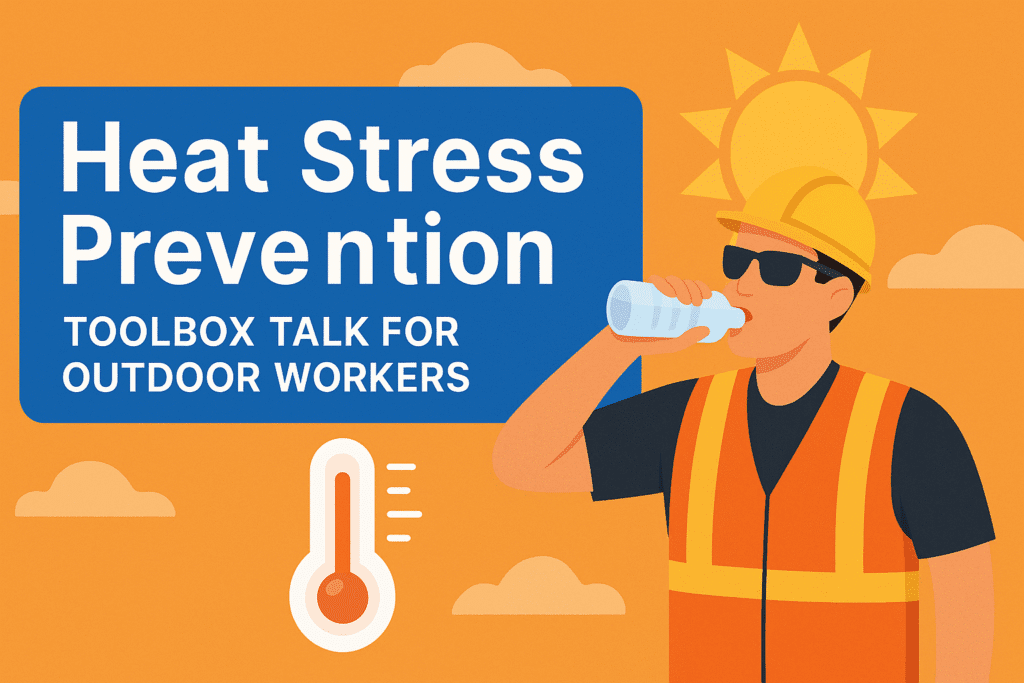
Heat Stress Prevention Toolbox Talk
Good Morning Team,
Today, we will focus on an important topic that becomes even more critical during hot seasons — Heat Stress Prevention. Working in high-temperature environments, especially outdoors, can put our health and safety at serious risk.
This toolbox talk will help you:
- Understand what heat stress is and why it’s dangerous.
- Identify early symptoms before they become life-threatening.
- Apply proven strategies to prevent heat-related illnesses.
- Learn what to do in emergencies.
Remember — heat-related illnesses are 100% preventable if we follow the right safety measures.
1️⃣ Understanding Heat Stress
Heat stress happens when the body cannot cool itself enough to maintain a safe core temperature (about 37°C / 98.6°F).
This can happen outdoors in hot weather or indoors near furnaces, boilers, or other heat sources.
How the body cools itself:
- Sweating
- Blood circulation to the skin
- Breathing out heat
When cooling fails:
- Excessive sweating leads to dehydration.
- Internal temperature rises.
- The body’s organs start overheating, leading to medical emergencies.
2️⃣ Causes of Heat Stress in Outdoor Work
- Direct sunlight exposure without shade.
- High humidity, which slows down sweat evaporation.
- Heavy physical labor, such as construction, roadwork, or agricultural tasks.
- Wearing heavy PPE or non-breathable clothing.
- Poor ventilation in indoor hot work areas.
3️⃣ Why Heat Stress is Dangerous
If heat stress is ignored, it can progress through stages:
A. Heat Cramps – Painful muscle cramps caused by loss of salt and water through sweat.
B. Heat Exhaustion – The body struggles to cool itself; symptoms include dizziness and nausea.
C. Heat Stroke – The body’s temperature regulation fails completely; this is life-threatening.
Impact on work:
- Reduced concentration → increased accident risk.
- Slower reaction times → unsafe decisions.
- Potential fatalities if untreated.
4️⃣ High-Risk Workers & Situations
- New workers not used to heat (lack of acclimatization).
- Workers with pre-existing health issues (heart problems, diabetes).
- Older workers (less efficient body cooling).
- Tasks involving heavy machinery in the sun.
- Wearing impermeable PPE for hazardous materials.
5️⃣ Warning Signs and Symptoms
Heat Cramps
- Painful muscle cramps (arms, legs, stomach)
- Heavy sweating
Heat Exhaustion
- Weakness, fatigue
- Dizziness, headache
- Nausea, vomiting
- Moist, cool skin
Heat Stroke (Medical Emergency)
- Confusion, slurred speech
- Loss of consciousness
- Hot, dry skin (no sweating)
- High body temperature above 40°C (104°F)
🚨 Heat stroke requires immediate emergency response — call for help immediately.
6️⃣ Prevention Strategies
A. Hydration
- Drink small amounts of water every 15–20 minutes.
- Avoid caffeinated and alcoholic drinks.
- Use electrolyte solutions during long work periods in extreme heat.
B. Work Scheduling
- Start heavy tasks early in the morning.
- Rotate tasks between workers.
- Ensure shaded or air-conditioned rest breaks.
C. Clothing & PPE
- Wear light-colored, loose-fitting clothes.
- Use breathable PPE if possible.
- Wear hats, sunglasses, and apply sunscreen.
D. Engineering & Administrative Controls
- Provide shade structures or canopies.
- Install fans or portable cooling units.
- Train workers in heat stress recognition.
7️⃣ First Aid Response for Heat Illnesses
For Heat Cramps:
- Stop work, move to cool area.
- Drink water/electrolyte solution.
- Stretch and massage affected muscles.
For Heat Exhaustion:
- Rest in a shaded area.
- Loosen tight clothing.
- Apply cool, wet cloths.
- Drink water slowly.
For Heat Stroke:
- Call emergency services immediately.
- Move victim to a cool place.
- Remove excess clothing.
- Apply ice packs or cold wet cloths.
- Do not give fluids if unconscious.
8️⃣ OSHA & International Guidelines
OSHA Recommendations:
- Water, rest, and shade policy.
- Acclimatization schedule for new workers.
- Emergency response plan for heat-related illnesses.
International Guidelines (ILO, WHO):
- Limit exposure during extreme heat waves.
- Educate workers on symptoms.
- Monitor workplace temperatures.
📄 Reference: OSHA Heat Illness Prevention
9️⃣ Real-World Case Study
Case:
In 2022, a road maintenance worker in Arizona collapsed from heat stroke after working in 41°C (106°F) temperatures for 5 hours straight.
Findings:
- No regular hydration breaks.
- Lack of shaded rest areas.
Actions Taken: - Introduced 20-minute rest breaks every hour.
- Provided portable shade tents.
- Trained supervisors to spot early warning signs.
🔟 Heat Stress Prevention Checklist
| Item | Yes/No | Remarks |
|---|---|---|
| Drinking water available nearby | ||
| Electrolyte drinks provided in extreme heat | ||
| Shaded rest area available | ||
| Breaks scheduled during hottest hours | ||
| Workers trained on heat stress | ||
| PPE suitable for hot weather | ||
| First aid kit available | ||
| Emergency contact numbers posted | ||
| Buddy system in place | ||
| Workers acclimatized to heat |
📥 Download Full PDF Checklist – (Add link here)
1️⃣1️⃣ Discussion Points for Toolbox Talk
- What are the first signs of heat stress you should watch for in your co-workers?
- How can you modify work schedules to reduce heat exposure?
- What personal steps can you take to stay hydrated and cool?
1️⃣2️⃣ Closing Remarks
Team,
Heat stress doesn’t just affect productivity — it can be deadly. By staying hydrated, taking breaks, wearing proper clothing, and looking out for each other, we can keep our workplace safe.
Remember:
- Heat illness is preventable.
- Early recognition saves lives.
- Safety is everyone’s responsibility.
Thank you for your attention. Let’s work smart and safe today.
Emergency Evacuation Procedures – Step-by-Step Workplace Guide
Lockout and Tagout – LOTO Safety Procedure
How to Perform a Fire Risk Assessment in the Workplace – Step-by-Step Guide
How to Conduct a Dynamic Risk Assessment in Real-Time Work Environments
Electrical Safety Inspection Checklist | Free Downloadable Template